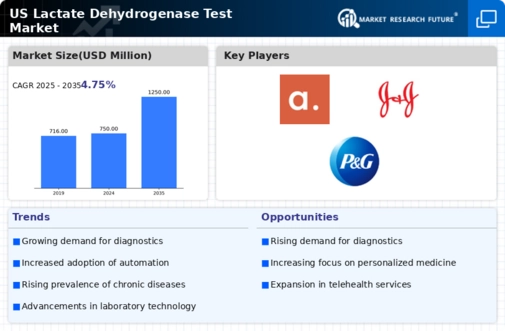Growing Demand for Diagnostic Testing
The lactate dehydrogenase-test market is experiencing a notable increase in demand for diagnostic testing. This trend is driven by the rising awareness among healthcare providers and patients regarding the importance of early disease detection. As healthcare systems in the US emphasize preventive measures, the need for accurate and timely diagnostic tests, including lactate dehydrogenase tests, is becoming more pronounced. The market is projected to grow at a CAGR of approximately 6.5% over the next few years, reflecting the increasing reliance on laboratory tests for diagnosing various conditions. This growth is further supported by advancements in laboratory technology, which enhance the accuracy and efficiency of testing processes, thereby boosting the overall market for lactate dehydrogenase tests.
Expansion of Healthcare Infrastructure
The expansion of healthcare infrastructure in the US is significantly impacting the lactate dehydrogenase-test market. With the establishment of new hospitals, clinics, and diagnostic laboratories, access to testing services is improving. This expansion is particularly evident in underserved areas, where the availability of diagnostic tests is crucial for timely medical intervention. As healthcare facilities invest in modern equipment and technologies, the efficiency of lactate dehydrogenase testing is likely to improve, leading to increased adoption. Furthermore, the US government has been allocating funds to enhance healthcare services, which may further stimulate the growth of the lactate dehydrogenase-test market. The overall market is expected to benefit from this infrastructural development, potentially increasing the number of tests conducted annually.
Technological Innovations in Testing Methods
Technological innovations are playing a crucial role in shaping the lactate dehydrogenase-test market. The introduction of advanced testing methods, such as point-of-care testing and automated laboratory systems, is enhancing the efficiency and accuracy of lactate dehydrogenase tests. These innovations allow for quicker turnaround times and improved patient outcomes, which are essential in critical care settings. As healthcare providers seek to optimize their testing processes, the adoption of these technologies is likely to increase. Furthermore, the integration of digital health solutions, such as telemedicine and electronic health records, is facilitating better data management and patient tracking, which may further drive the demand for lactate dehydrogenase testing. The market is expected to benefit from these technological advancements, potentially leading to a more streamlined testing process.
Increase in Research and Development Activities
The lactate dehydrogenase-test market is witnessing an increase in research and development activities aimed at enhancing the understanding of lactate dehydrogenase's role in various diseases. This surge in R&D is driven by the need for more precise diagnostic tools and the exploration of new therapeutic applications. Academic institutions and pharmaceutical companies are investing in studies that investigate the correlation between lactate dehydrogenase levels and disease states, which may lead to the development of novel testing methodologies. As these research initiatives progress, they are likely to contribute to the expansion of the lactate dehydrogenase-test market by introducing innovative testing solutions and expanding the clinical applications of the test. This focus on R&D may result in a more robust market landscape, fostering growth opportunities.
Rising Awareness of Lactate Dehydrogenase Testing
There is a growing awareness among healthcare professionals and patients regarding the significance of lactate dehydrogenase testing in diagnosing various medical conditions. This awareness is being fueled by educational initiatives and research publications that highlight the role of lactate dehydrogenase as a biomarker for tissue damage and disease progression. As a result, healthcare providers are increasingly incorporating lactate dehydrogenase tests into their diagnostic protocols. This trend is likely to enhance the market's growth, as more patients are referred for testing. The lactate dehydrogenase-test market is projected to see a rise in utilization rates, potentially leading to a market value increase of around 8% over the next five years, as more clinicians recognize the test's diagnostic value.














Leave a Comment